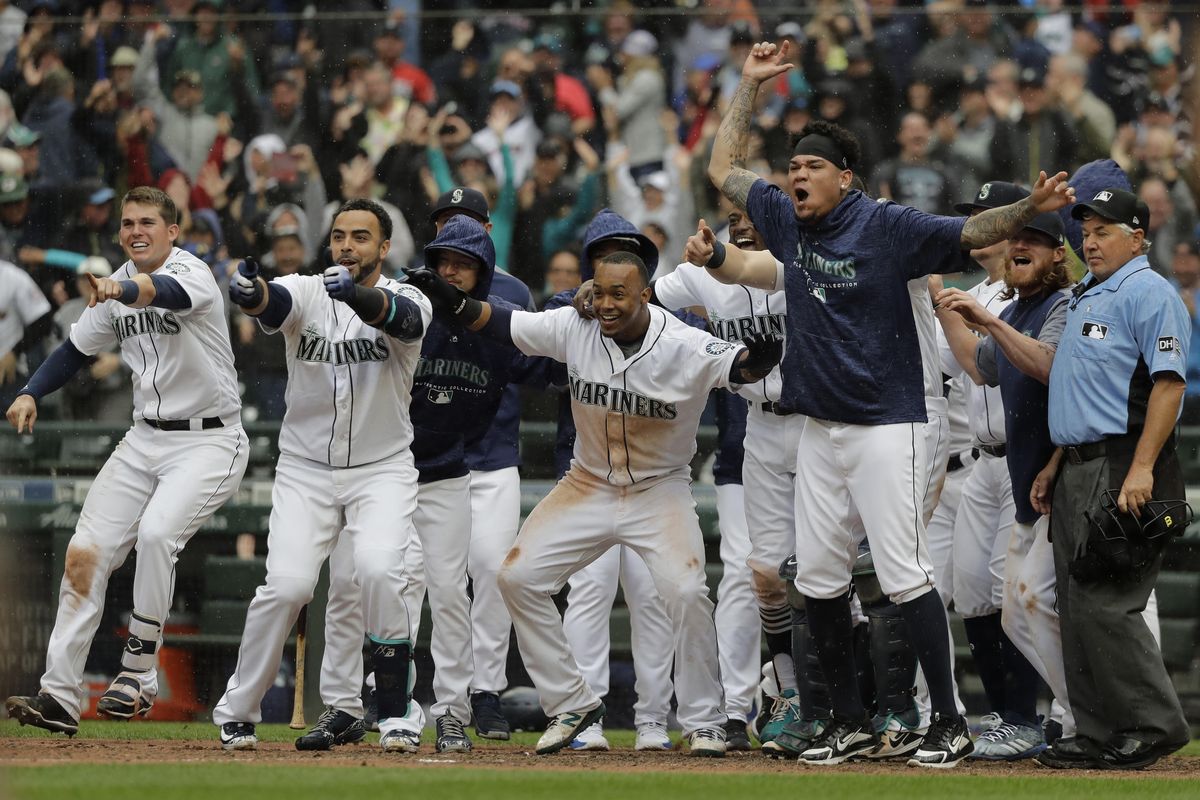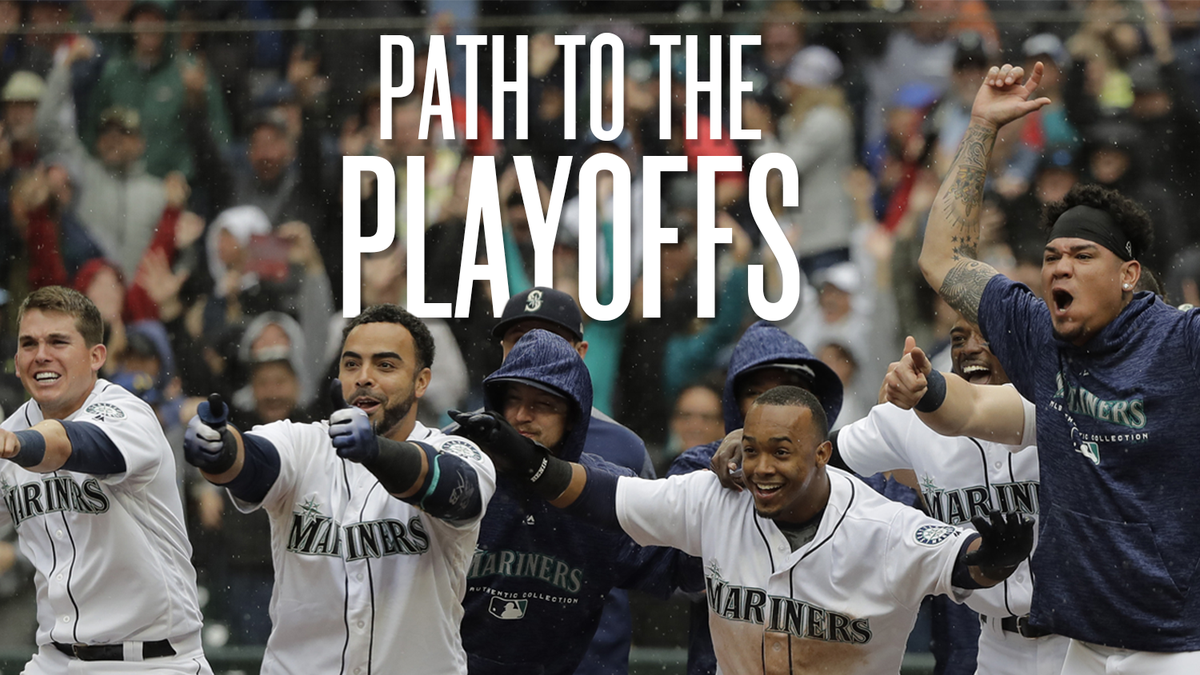Analysis: The Mariners are on pace to make the playoffs. But … how?
Seattle Mariners, including Jean Segura, center, who scored the winning run on a two-run walk-off home run by Mitch Haniger, wait for Haniger at the plate during the ninth inning against the Los Angeles Angels on June 13 in Seattle. (Ted S. Warren / Associated Press)
SEATTLE – Maybe it’s the way the Mariners crawled across the first-half finish line like a person running a marathon without actually training for it, losing eight of their last 12 games, including their last four in a row and three straight series.
Perhaps it’s the way the Oakland Athletics didn’t stumble and trip in the final weeks before the All-Star break, instead surging to the four-day hiatus and narrowing the gap between them and the Mariners to a weekend’s worth of games.
Two weeks ago, it wasn’t a matter of whether or not the Mariners would make the postseason, which seems odd since that hasn’t happened since 2001. No, it was more about who they would play in the wild-card game or if catching the Astros could be a reality.
But now there is lingering apprehension bordering on panic for many fans going into the second half of the season. Will they add another pitcher? Will Robinson Cano’s return help or hurt the team? Will they fold?
Fancy baseball phrases like “negative run differential” and “regression to the mean” are also being used in conjunction with “same old Mariners.”
That the Mariners are in the midst of these conversations means something or many things still had to go right in the first half of the season. In far too many seasons past, the discussion after the All-Star break was which pieces could the sinking team pawn off to contenders.
Let’s reassess for a moment.
The Mariners are 58-39 through 97 games. That’s a .598 winning percentage, fourth best in club history through 97 games in a season. Only 2001 (.722/70-27), 2002 (.619/60-37) and 2003 (.608/59-38) were better.
They have the fourth-most wins of any team in the majors. Their lead over the A’s in the second wild card was once nine games and is now down to three. But it’s taken a 20-6 run by the A’s to help narrow that gap. That sort of pace by Oakland isn’t sustainable.
They’ve done all of this with Cano, their best overall hitter, playing in just 39 games because of a violation of the MLB joint drug-testing program, along with stints on the disabled list from Mike Zunino, Nelson Cruz, Ryon Healy and Dee Gordon.
“I think we’ve had an awesome first half of the season,” M’s manager Scott Servais said. “It’s a credit to our players. We’ve certainly faced some adversity, dealing with injuries, losing Robbie and things like that to still get us in this position, I couldn’t be any happier.”
Yet even Servais was frustrated by the final 12 days before the break.
“You’re always a little disappointed because we’re in a little bit of a swoon and haven’t played that great recently,” he said. “But you have to look at the big picture here. And that’s one thing I try to do better job of since I’ve been here. You have to stand back and say, ‘When we left Peoria, what were we shooting for? What were we hoping for?’ ”
Realistically, the Mariners and all their fans would have happily taken 19 games above .500 and a lead in the second wild-card race at the All-Star break if offered at the beginning of the season. But it shows how expectations can change during the season. This somehow feels like coming up short given they were 24 games above .500 (55-31) and eight games up on the A’s and a half-game behind the Astros on July 3.
“At the end of the day, we’ve still put ourselves in a tremendous position to have an awesome run at this thing to get into the playoffs,” Servais said.
How did they do that? Well, it’s been pitching, one-run wins, timely hitting, the dominance of Edwin Diaz, the consistency of Jean Segura and Mitch Haniger, and a little luck.
On May 13 at Comerica Park, the Mariners watched Cano crumble in the batter’s box, taking an 88 mph fastball off his right hand. The sickening sound of baseball smashing his hand against the bat made it obvious something was broken. The only question was how long would the Mariners be without their No. 3 hitter and All-Star second baseman. That answer came two days later when the team and MLB announced that Cano had been suspended for 80 games for testing positive for Furosemide – a diuretic that masks the performance-enhancing drugs.
It was easy to assume that the Mariners would be done. It’s one thing to be without Cano for six weeks while his hand recovered, but 80 games?
Seattle won later that night on a walkoff hit by Guillermo Heredia, sparking a 23-8 run.
“Nobody thought we could win without Robbie,” Segura said. “But we did. Guys stepped up.”
No player moreso than Segura.
Since Cano’s suspension announcement, he’s hitting .337 with an .852 on-base plus slugging percentage, 12 doubles, a triple, five homers, 20 RBIs and 40 runs scored.
Also during that 31-game stretch following Cano’s suspension, the Mariners were 14-3 in one-run games. For the season, they are 26-11 in one-run games, the best in baseball. Diaz has saved 20 of those games.
Sabermetricians will point out the luck factor in deciding one-run games, which is true, but the Mariners made their own luck by getting the ball to Diaz with a lead. They are 44-0 when Diaz enters a game with a lead this season. He has 36 saves in 39 chances, meaning the Mariners still won the three games he blew the save.
“You talk about the first half of the season and so many guys have played key roles so far,” Servais said. “But maybe nobody bigger than him. When you win all the close games and have that guy at the back end to turn it over to and have him come through as many times as he has in the one-run games, it’s not easy.”
The Mariners don’t wow you with statistical dominance. Their offense is about average, which was unexpected. Their pitching has been better than average, which also was unexpected.
“Things played out much differently,” Servais said. “I think when we left Peoria we really thought we were going to be an offensive juggernaut. We loved the lineup and what we were going to do offensively. Things have changed a little bit. On the flip side, our pitching as has been really, really good. There’s a lot of ways to get it done. I still like our offense and where we are headed. Overall, the first half, I’m very happy with what we’ve done.
Happy? Yes. Satisfied? Not a chance.
“As good as things have been, there’s still room for improvement for guys to step up in the second half,” Servais said. “We need it.”
The Mariners played themselves into this winning record and also the grind that is a second-half postseason race.
It means day-to-day watching of the scoreboard and the outcome of each game in relation to the standings. Losing a winnable game hurts just a little more. Each game becomes a little more magnified. It’s an anxiety that hasn’t been felt at Safeco much past the month of August and September during recent seasons.
“It’s exactly what we talked about wanting to happen for our fan base and the vibe around Safeco,” Servais said. “It’s going to be there for the second half and it’s going to be a lot of fun.”

